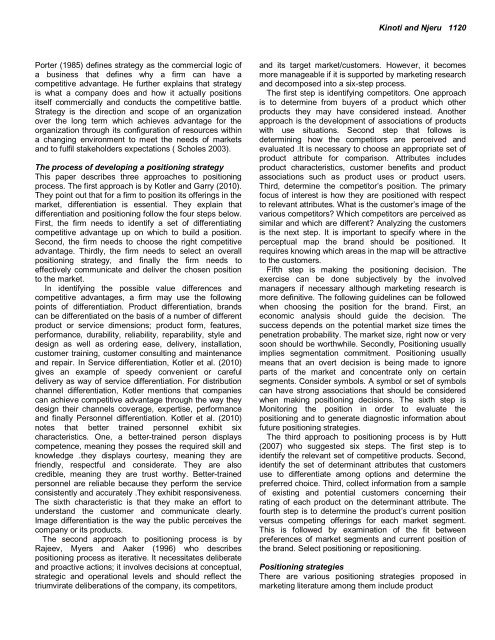Full Article (PDF) - Prime Journals
Full Article (PDF) - Prime Journals
Full Article (PDF) - Prime Journals
You also want an ePaper? Increase the reach of your titles
YUMPU automatically turns print PDFs into web optimized ePapers that Google loves.
Kinoti and Njeru 1120<br />
Porter (1985) defines strategy as the commercial logic of<br />
a business that defines why a firm can have a<br />
competitive advantage. He further explains that strategy<br />
is what a company does and how it actually positions<br />
itself commercially and conducts the competitive battle.<br />
Strategy is the direction and scope of an organization<br />
over the long term which achieves advantage for the<br />
organization through its configuration of resources within<br />
a changing environment to meet the needs of markets<br />
and to fulfil stakeholders expectations ( Scholes 2003).<br />
The process of developing a positioning strategy<br />
This paper describes three approaches to positioning<br />
process. The first approach is by Kotler and Garry (2010).<br />
They point out that for a firm to position its offerings in the<br />
market, differentiation is essential. They explain that<br />
differentiation and positioning follow the four steps below.<br />
First, the firm needs to identify a set of differentiating<br />
competitive advantage up on which to build a position.<br />
Second, the firm needs to choose the right competitive<br />
advantage. Thirdly, the firm needs to select an overall<br />
positioning strategy, and finally the firm needs to<br />
effectively communicate and deliver the chosen position<br />
to the market.<br />
In identifying the possible value differences and<br />
competitive advantages, a firm may use the following<br />
points of differentiation. Product differentiation, brands<br />
can be differentiated on the basis of a number of different<br />
product or service dimensions; product form, features,<br />
performance, durability, reliability, reparability, style and<br />
design as well as ordering ease, delivery, installation,<br />
customer training, customer consulting and maintenance<br />
and repair. In Service differentiation, Kotler et al. (2010)<br />
gives an example of speedy convenient or careful<br />
delivery as way of service differentiation. For distribution<br />
channel differentiation, Kotler mentions that companies<br />
can achieve competitive advantage through the way they<br />
design their channels coverage, expertise, performance<br />
and finally Personnel differentiation. Kotler et al. (2010)<br />
notes that better trained personnel exhibit six<br />
characteristics. One, a better-trained person displays<br />
competence, meaning they posses the required skill and<br />
knowledge .they displays courtesy, meaning they are<br />
friendly, respectful and considerate. They are also<br />
credible, meaning they are trust worthy. Better-trained<br />
personnel are reliable because they perform the service<br />
consistently and accurately .They exhibit responsiveness.<br />
The sixth characteristic is that they make an effort to<br />
understand the customer and communicate clearly.<br />
Image differentiation is the way the public perceives the<br />
company or its products.<br />
The second approach to positioning process is by<br />
Rajeev, Myers and Aaker (1996) who describes<br />
positioning process as iterative. It necessitates deliberate<br />
and proactive actions; it involves decisions at conceptual,<br />
strategic and operational levels and should reflect the<br />
triumvirate deliberations of the company, its competitors,<br />
and its target market/customers. However, it becomes<br />
more manageable if it is supported by marketing research<br />
and decomposed into a six-step process.<br />
The first step is identifying competitors. One approach<br />
is to determine from buyers of a product which other<br />
products they may have considered instead. Another<br />
approach is the development of associations of products<br />
with use situations. Second step that follows is<br />
determining how the competitors are perceived and<br />
evaluated .It is necessary to choose an appropriate set of<br />
product attribute for comparison. Attributes includes<br />
product characteristics, customer benefits and product<br />
associations such as product uses or product users.<br />
Third, determine the competitor‟s position. The primary<br />
focus of interest is how they are positioned with respect<br />
to relevant attributes. What is the customer‟s image of the<br />
various competitors? Which competitors are perceived as<br />
similar and which are different? Analyzing the customers<br />
is the next step. It is important to specify where in the<br />
perceptual map the brand should be positioned. It<br />
requires knowing which areas in the map will be attractive<br />
to the customers.<br />
Fifth step is making the positioning decision. The<br />
exercise can be done subjectively by the involved<br />
managers if necessary although marketing research is<br />
more definitive. The following guidelines can be followed<br />
when choosing the position for the brand. First, an<br />
economic analysis should guide the decision. The<br />
success depends on the potential market size times the<br />
penetration probability. The market size, right now or very<br />
soon should be worthwhile. Secondly, Positioning usually<br />
implies segmentation commitment. Positioning usually<br />
means that an overt decision is being made to ignore<br />
parts of the market and concentrate only on certain<br />
segments. Consider symbols. A symbol or set of symbols<br />
can have strong associations that should be considered<br />
when making positioning decisions. The sixth step is<br />
Monitoring the position in order to evaluate the<br />
positioning and to generate diagnostic information about<br />
future positioning strategies.<br />
The third approach to positioning process is by Hutt<br />
(2007) who suggested six steps. The first step is to<br />
identify the relevant set of competitive products. Second,<br />
identify the set of determinant attributes that customers<br />
use to differentiate among options and determine the<br />
preferred choice. Third, collect information from a sample<br />
of existing and potential customers concerning their<br />
rating of each product on the determinant attribute. The<br />
fourth step is to determine the product‟s current position<br />
versus competing offerings for each market segment.<br />
This is followed by examination of the fit between<br />
preferences of market segments and current position of<br />
the brand. Select positioning or repositioning.<br />
Positioning strategies<br />
There are various positioning strategies proposed in<br />
marketing literature among them include product





![See Full Article [pdf] - prime journals limited](https://img.yumpu.com/49292987/1/190x245/see-full-article-pdf-prime-journals-limited.jpg?quality=85)



![See Full Article [pdf] - Prime Journals](https://img.yumpu.com/44526114/1/190x245/see-full-article-pdf-prime-journals.jpg?quality=85)


![See Full Article [pdf] - prime journals limited](https://img.yumpu.com/42270022/1/190x245/see-full-article-pdf-prime-journals-limited.jpg?quality=85)

![See Full Article [pdf] - Prime Journals](https://img.yumpu.com/41607332/1/190x245/see-full-article-pdf-prime-journals.jpg?quality=85)
![See Full Article [pdf] - Prime Journals](https://img.yumpu.com/41231982/1/190x245/see-full-article-pdf-prime-journals.jpg?quality=85)
